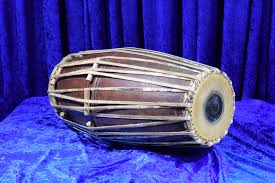
The mridangam is a South Indian drum that goes back as far as 200 BC. The instrument itself is laid on one’s lap and struck on both sides to create different sounds. The left side of the instrument reaches an octave lower than the right side. Its origins connect to Carnatic classical music practices, which is mostly vocal repertoire with some instrumental accompaniment. This type of music sprung from Hindu music practices and is mostly improvised with some written scores. The sound of the instrument is intricate however it has a higher pitch due to the size of the drum.
The instrument itself has ties to several Hindu gods such as Ganesh and Shiva. The instrument has an importance in the Hindu faith and there are many different stories claiming its origin as it relates to each of the Gods. Although people still use the instrument in some meditation and religious practices, the mridangam is also used secularly. Many schools still teach the foundations of this instrument and due to its popularity, there are many performers who have gained their fame from playing the instrument.
The mridangam used to be made from clay. This is obvious as the name is even derived from its original materials. “Mrid” means clay and “ang” means body. However, this material eventually grew out of popularity and the instrument from then on has been made from various types of wood and animal skins. Some of the types of woods used include jack wood (which is the most popular) or redwood. They take one piece of the wood and they carve it to make the entire body. In modern mridangam making they are able to use heavy machinery to cut, sand and carve these bodies. The approximate sizes anywhere from 1.5 to 2 feet long and 25-30 cm in diameter. One side of the drum has a larger diameter in order to be an octave lower than the other side. Different skins from animals such as goats, calf, sheep and buffalo are used to line and create the drumheads. The instrument also features several leather bindings that can be tightened to change the pitch of the instrument.
In order to properly learn the mridangam you must practice aurally the rhythmic patterns that are vital to the performance of the instrument. These patterns are called taals and the individual sounds created from them are called bols. There are four different types of bols in mridangam practicing including chapu, dhi, tha, and thom each sounded using a different hand position. Once you learn these patterns you are able to slowly incorporate the instrument.
Try to learn one of these exercises here!
Overall the mridangam is an instrument that has evolved with the course of history. In our modern day it is easy to learn the mridangam from your own home with the help of online videos and lessons. They have made synthetic mridangams as a more affordable and ecofriendly option to learning the instrument. The mridangam will always have a place in music history from its ancient upbringing to the continued practice in today’s ever-changing world.
Works Cited
Kasliwal, Suneera. “Mridangam.” Mridangam – India Instruments, 2001, www.india- instruments.com/encyclopedia-mridangam.html.
“Mridangam.” E-Learning Courses, Ipassio, www.ipassio.com/hobbies/percussion- instruments/mridangam.
The Editors of Encyclopaedia Britannica. Mridangam. 23 Sept. 2011, www.britannica.com/art/mridangam.
The Editors of Encyclopaedia Britannica. “Karnatak Music.” Encyclopædia Britannica, Encyclopaedia Britannica, Inc., 1 Apr. 2020, www.britannica.com/art/Karnatak-music.
Written by Courtney Parrish
Categories
Calendar
| M | T | W | T | F | S | S |
|---|---|---|---|---|---|---|
| 1 | 2 | 3 | 4 | 5 | 6 | |
| 7 | 8 | 9 | 10 | 11 | 12 | 13 |
| 14 | 15 | 16 | 17 | 18 | 19 | 20 |
| 21 | 22 | 23 | 24 | 25 | 26 | 27 |
| 28 | 29 | 30 | 31 | |||